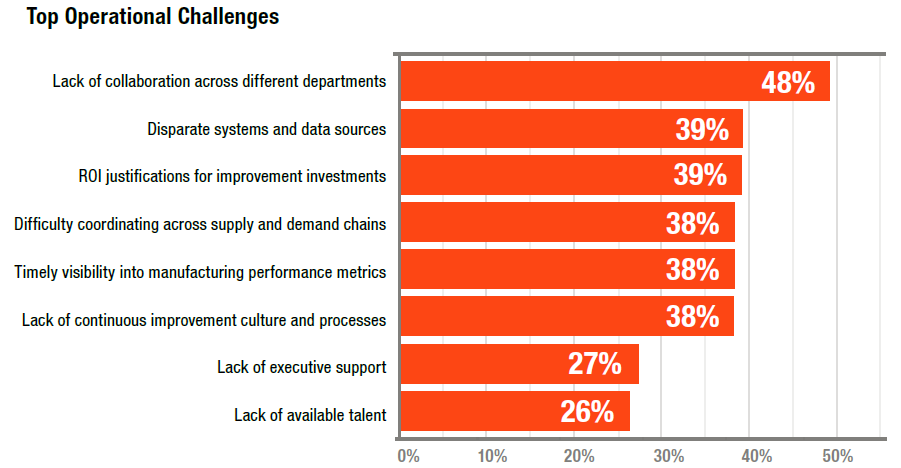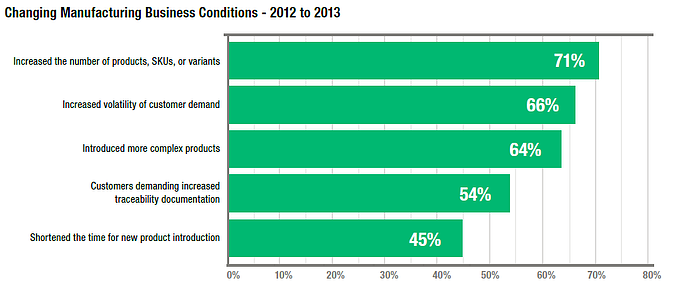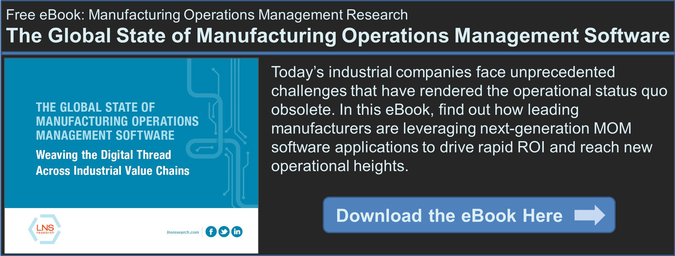Today, everyone is talking about technology advancements. References to the Cloud, Mobile, Big Data, the Internet of Things (IoT)—whether central talking points or tangential nuggets that bounce in and out of conversation—have become near ubiquitous across manufacturing industries. It seems clear—most professionals seem to understand at least on some level where the future trends lie in technology for operations.
But do they understand how they currently stack up to competitors? Do they grasp how their current capabilities (or lack thereof) position their companies to meet organizational objectives and face challenges as we move into 2015 and beyond?
Research suggests there is still work to do in education about the current state of the marketplace and the level of benefit and capability seen as companies move toward a more digitized, seamless flow of information—what’s known as the Digital Thread. In this post, we’ll discuss the current state of manufacturing operational goals and challenges, what’s shifting, and how reliance on legacy systems and manual processes is holding many companies back from achieving manufacturing and enterprise-level goals.
Connecting to Customer Demands
It probably comes as no surprise, but manufacturers across industries are heavily focused on the wants and needs of their customers. When asked about top objectives in our Manufacturing Operations Management (MOM) survey, meeting customer demands was second only to ensuring consistent product quality, at 55% vs. 61% of responses.
As manufacturers know well by now, in order to connect to this customer perspective and demand, it’s critical to have immediate and actionable information at hand to constantly inform all key stakeholders to make correct and timely decisions. This is monumentally difficult to achieve when you have an architecture of legacy systems and software that lack the ability to intercommunicate, contextualize data by role, and serve redundant purposes.

And research bears this out: As seen in the graph above, the top two operational challenges in meeting goals are highly related to technology and process capabilities.
It’s worth mentioning that this snapshot of operational challenges doesn’t exist in a vacuum. This is the present reaction to the market as it stands today, but, as always, things are changing rapidly on that front as well, as we’ll see below in illustrating how business conditions are changing as time progresses.

As we can see, these five conditions read as the start of a customer litany of requests: they’re more fickle overall, and they want a greater number of higher-complexity products in a shorter amount of time with greater visibility into how they’re made. In short, responding accurately and adequately to customer demands and expectations is growing more difficult with each passing year, placing even further strains on legacy systems than shown above.
It’s applicable across the board, but particularly in specific, concentrated, highly challenging industries—aerospace & defense, electronics, life sciences—the legacy systems of the past are rapidly becoming obsolete.
How the Digital Thread Is Helping Manufacturers Respond and Achieve Operational Excellence
Forward thinking manufacturing organizations have seen these trends coming, and are beginning to invest in emerging Digital Thread technologies—those that enable a single, bi-directional flow of digitized information across the value chain—into their operations. Cloud, Mobile, Big Data, and the Internet of Things are all important strands of the Digital Thread, breaking down informational silos to foster collaboration by:
- Enabling streamlined collaboration of product and process designs into manufacturing operations
- Providing real-time, role-based data on mobile devices
- Tying quality, asset management, scheduling & planning, customer sentiment into decision-making across departments
- Supporting closed-loop quality and end-to-end product traceability capabilities
- Extracting additional information from structured and unstructured data to better forecast and make decisions
With these and other capabilities integrated into companies’ operations, manufacturers find themselves in a much better position to extract and execute on information and workflows, greatly enhancing operational agility, and allowing operations to move from the extreme reactive toward a proactive operational model.
Time Is of the Essence
It’s important to remember that even if you’re still achieving your goals with your current, legacy IT architecture, this bar will always rise. You need to consider not only the growing wants and desires of customers outlined above, but the investments your competitors are making. As technologies improve and costs decrease, as my colleague Dan Miklovic described in his post yesterday, there will come a tipping point where Digital Thread capabilities will separate successful companies from bottom feeders—and you know which side you want to be on.
